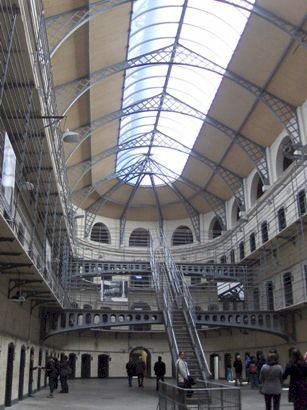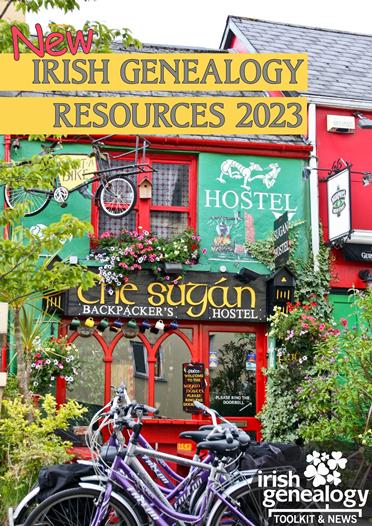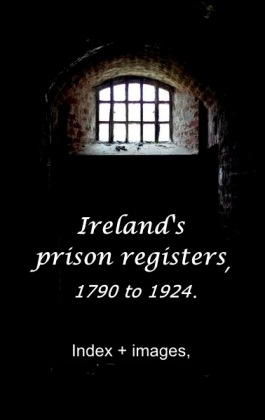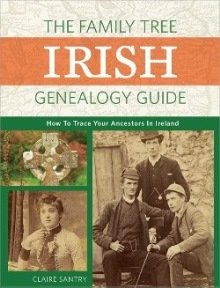- Home ›
- Irish genealogy A-Z ›
- Irish prison registers
Irish prison registers
Irish prison registers are a source of fascinating detail about the Ireland our ancestors lived in. Not only do they reflect society, with its sometimes inexplicably peculiar notions of acceptable and unacceptable behaviour, they also reveal the overwhelming poverty, destitution and desperation experience by large swathes of the population.
In addition to the tale they tell on society, they can also provide some quite breathtaking genealogical information that you are unlikely to find elsewhere in your family history research.
Irish prison registers - online
 Kilmainham Gaol, Dublin: many of this prison's famous and infamous residents are recorded in the Irish prison registers collection.
Kilmainham Gaol, Dublin: many of this prison's famous and infamous residents are recorded in the Irish prison registers collection.Irish prison registers are a source of fascinating detail about the Ireland our ancestors lived in. Not only do they reflect society, with its sometimes inexplicably peculiar notions of acceptable and unacceptable behaviour, they also reveal the overwhelming poverty, destitution and desperation of large swathes of the population.
 Kilmainham Gaol, Dublin: many of this prison's famous and infamous residents are recorded in the Irish prison registers collection.
Kilmainham Gaol, Dublin: many of this prison's famous and infamous residents are recorded in the Irish prison registers collection.In addition to the tale they tell on society, they can also provide some quite breathtaking genealogical information that you are unlikely to find elsewhere in your family history research.
Irish prison registers - online
The Irish Prison Registers collection holds the entire record-set previously available only in unindexed hard copy at the National Archives of Ireland.
Hightlights of the collection:
- A total of 3,127,594 records, fully indexed and linked to register images.
- Registers are from prisons located in the Republic of Ireland only. See below (on mobiles) or right (on other devices) for Northern Irish prison registers).
- Earliest registers date to 1790; most recent to 1924.
- Both the accused and the victims of crime can be searched.
With an average population of around 4million during the period this collection covers, few families will not have had some brush with the law. This means that most researchers should be able to find a connection somewhere within this collection.
Details of the collection
The Irish prison registers collection covers the full range of detention facilities available from 1790 to 1924. Registers have survived from bridewells, which were cell blocks of varying sizes attached to local police stations or courthouses, to the county or national prisons, and to the specialised 'drying out' Prisons for Inebriates. Which is not to say that the collection is complete. Of course it isn't. This is Irish genealogy, after all.
All kinds of reasons
You might imagine that all your ancestors were perfectly law-abiding and, as such, were unlikely to appear in the Irish prison registers.
But you should bear in mind that while they may not have been career criminals, there were all kinds of reasons that they may have had a brush with the law.
The collection is made up of a total of 44 registers from 20 of the 26 counties in modern-day Ireland: Clare (1), Cork (15), Dublin (6), Galway (2), Kerry (1), Kildare (2), Kilkenny (1), Laois (2), Lietrim (1), Limerick (1), Longford (1), Louth (1), Mayo (1), Meath (1), Offaly (1), Sligo (1), Tipperary (2), Waterford (1), Wexford (2), Wicklow (1).
All kinds of reasons
You might imagine that all your ancestors were perfectly law-abiding and, as such, were unlikely to appear in the Irish prison registers. But you should bear in mind that while they may not have been career criminals, there were all kinds of reasons that they may have had a brush with the law.
Some are relatively recent – the Dundalk register, for example, dates from 1917-1924 – while Dublin's Kilmainham register spans the greater period, having started in 1789 and ended in 1910. Most date from the 1840s to near the end of the 19th century.
All the names that appear in the Irish Prison registers (prisoners, relatives and victims) can be searched. Searches can also be carried out, with a surname, for a specific timeframe or prison.
The
"County" field refers to the geographic location of the prison, not
the home town or birthplace of the prisoner.
What these registers reveal
The information noted in the Irish prison registers varied over time and according to the type of detention facility. Bridewells typically recording less information. The county courts generally recorded:
- Name
- Address
- Place of birth
- Occupation
- Religion
- Education
- Age
- Physical description
- Name and address of next of kin
- Crime committed (including the name and address of any victim)
- Sentence or discharge, or date and place of committal.
Examples of entries found in the Irish prison registers collection
Stealing potatoes: John Lane, aged just 10 years, was found guilty of stealing potatoes. He was sentenced to ten days hard labour in August 1849. See section below for more about 1849.
Prostitution: 36-year-old Julia Tobin, aka Julia Ryan, charged with Importuning passers-by for prostitution in December 1870. This was her 14th arrest. She was sentenced to three months imprisonment or a fine of £2 1shilling. Nothing further is recorded.
An Irish Genealogy research essential!
Neglect of children and habitual drunkeness: Jane Allen, an illiterate 40-year-old born in Dungarvan, Waterford but living in Belfast, was convicted for a fifth time with neglecting her child and habitual drunkeness. She is recorded as just 4ft 10inches tall, with brown hair, grey eyes, a fresh complexion and a small scar on her left eyebrow. Her upper front teeth are also missing. She weighed 157lbs on arrival at Ennis Reformatory on 24 October 1907. After serving her two-year sentence she was released and returned to her husband, Daniel, at 62 Fleet Street, Belfast.
Stealing clothes: Mary Regan, aged 20, was found guilty of possession of stolen clothes at the Spring Assizes in 1826. She was sentenced to 7 years transportation and was sent to Cork Penetentiary to await her ship in September of that year.
Arson and treason: Daniel Santry, aged 19, was taken into custody at Cork prison on 6 March 1867 charged with attacking and burning the police barracks and open insurrection against HM The Queen. His home address is recorded and so are some personal details height 5ft 7½, fresh complexion, grey eyes, brown hair, and two vaccination marks on his left arm. Surprisingly, given the crime, he was bailed after 14 days incarceration and ordered to appear at the Spring Assizes.
Prison 'appeal' in 1849
The Irish prison registers show that the level of incaration leapt by nearly 15% in 1849. Just over 100,000 people went through the prison system in that one year alone as those worst affected by the famine sought refuge within prison.
At least there was food and shelter in prison, no matter how hard the regime. Often the food was better than in the workhouse, so people deliberately set out to be arrested.
There are many, many cases of 'stealing clothes from Workhouse' or stealing dishes from Workhouse. These are topped only by the incidences of petty theft for stealing potatoes, apples or turnips.
Some examples:
- Margaret (7), Mary (9) and John (5) Santry were held in custody from 17 July to 3 August 1849 when they were found not guilty of stealing sheep and discharged
- Patrick (14), Mary (12) and Daniel (6) McCarthy were arrested for vagrancy on 17 July 1849. The magistrate sentenced them to 14 days. Patrick was released a day later than his siblings because he was sick on the official discharge date.
- Ellen Carthy was sentenced to one month's hard labour, or a fine of 1shilling, for breaking a window at Skibbereen Workhouse in September 1849. She was aged 15.
What the registers reveal about the Irish stereotype
The top five offences recorded were:
- Drunkeness – 25%
- Theft – 16%
- Assault – 12%
- Vagrancy – 8%
- Rioting – 4%
► See Related Pages
Related pages
If you've found an entry for one of your ancestors in the Irish prison registers, a sensible next port of call would be one of the growing collections of historical newspapers, where you may find more details about their appearance before the beak.
- Sticking with crime and punishment, have you checked the Irish Petty Sessions records?
- The value of historical Irish newspapers, plus the top online collections
- The best free-to-access Irish newspaper archives and resources online and offline



